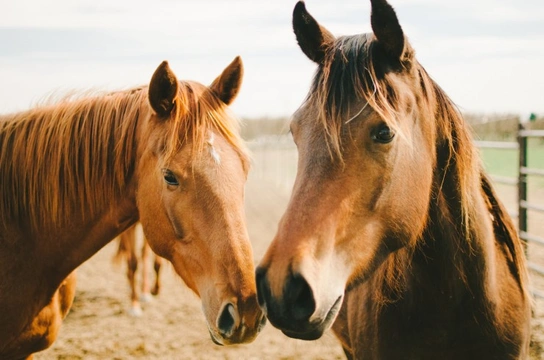
A Horse's Equivalent to the Common Cold
Many upper respiratory issues seen in horses are in fact the equivalent to the common cold seen in people because they are caused either by certain viruses and bacteria. Horses most at risk are those that frequently come into contact with other horses and those that have not been vaccinated. A horse can pick up a “bug” from another horse whether it's a newcomer to a yard or at show. The problem is they don't have to have direct contact with an infected horse to catch the bugs themselves.
Equine herpesvirus (EHV) being a prime example of a bug that can spread when a horse coughs or even when they clear their nostrils which means the germs are then airborne. Bacteria can also be found in water buckets as well as feed bowls, but people and insects can also be carriers. The incubation period once a horse has been infected is anything up to 36 hours of having been infected where flu is concerned, and 3 to 7 days for EHV to take hold. When a horse has been infected with Streptococcus equi more commonly known as strangles, it can take anything from 3 to 14 days for any symptoms to become apparent.
Most Common Clinical Signs
The most common sign of there being a problem is when a horse starts to cough and does so continuously with a nasty discharge coming from their noses. Their lymph nodes are often swollen and they develop a fever showing signs of depression. With an URT infection the first sign is for a horse to run a temperature which results in them going off their feed leading to anorexia. Should their temperature rise too high, it can lead to them becoming dehydrated. Luckily, in most cases horses develop a slight fever which quickly goes away with no need for veterinary intervention.
The danger is when a “carrier” spreads an infection and yet they have no symptoms of being ill themselves which means it's only when another horse goes down with an infection that owners begin to worry. Amazingly, figures show that around 80% of all horses have EHV in its latent form which they only transmit to other horses when they are put under any sort of stress. This is typically how horses stabled in barns or stable yards become infected too. Younger horses and foals together with mares in foal and older horses are more at risk of catching it from a “silent carrier” too.
Diagnosing the Problem
Once a horse is diagnosed as having a URT infection, you would have to take the necessary precautions to protect other horses in a yard or barn. Fortunately, today's modern techniques to test for these bugs makes it that much easier for vets who can take either a nasal or nasopharyngeal swab. The most common viral URT infections being as follows:
- Influenza
- Equine rhinitis virus
- EHV-1, -2, -4 and -5
- Equine arteritis virus
- Adenovirus
Where bacterial URT infections are concerned, these include strangles in adult horses and Rhodococcus in foals for which nasal swab tests can be done to screen if an animal is infected or not. However, as with many tests they have their limitations as it depends on which stage of an infection a test is carried out.
Treatments
As in humans who suffer colds, with horses rest and lots of fluids go a long way in treating the condition. However, getting a horse to drink enough water can prove challenging which means adding a little salt to their food to encourage them to drink or to offer them electrolytes. Another option is ensure they have access to a salt lick, but again there's no guarantee they will help themselves to it when they are feeling off colour. The general rule of thumb is when a horse has a “cold” they should be rested for 1 week for every single day they had a fever and for them to have at least 2 weeks off once they have recovered from an infection.
The reason this rest period is so important is that it takes the lining of a horse's respiratory tract around 21 days to regenerate and if not allowed to do so, a horse may be more susceptible to developing certain complications like pneumonia. When a viral infection has taken hold, it is crucial for a horse to rest as long as it takes to avoid putting them more at risk of developing recurring airway issues.
Prevention is the Key
As with most things prevention is the key which means vaccinating horses and any new horses arriving in a yard need to be quarantined for at minimum of 21 days. Should a horse show any symptoms, they should be kept away from other horses and all equipment needs to be disinfected to reduce the risk of an infection from spreading. However, it’s always a good idea to call out the vet if you are at all concerned because the earlier a condition is diagnosed, the easier it tends to be to treat.



